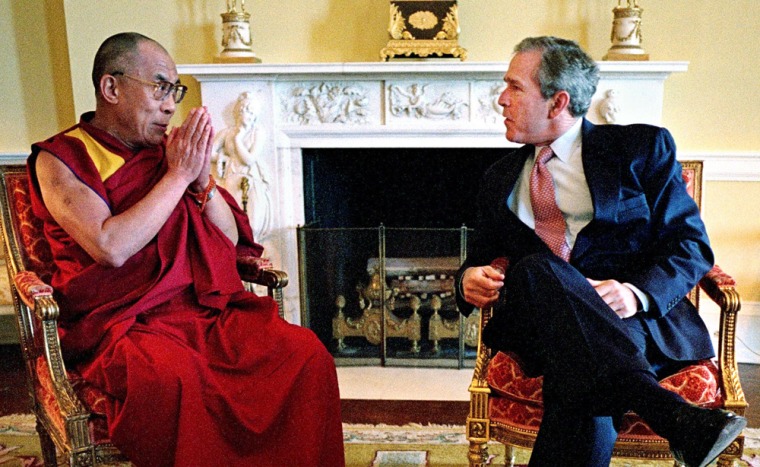Whether going before the United Nations to publicize the plight of Tibetans under Chinese rule or appearing in events with Hollywood celebrities, the 14th Dalai Lama of Tibetan Buddhism has become a familiar face to many Westerners. Here are answers to some essential questions about the first Lama to visit the West:
Who is the Dalai Lama?
The Dalai Lama is considered the head monk of Tibetan Buddhism and, by tradition, is responsible for governing the Himalayan country. The 14th Dalai Lama, Tenzin Gyatso, was born Lhamo Dhondub to a farming family in a northeastern Tibetan village in 1935. Buddhist officials recognized him as the reincarnation of the 13th Dalai Lama when he was two years old. Buddhists believe the successive Dalai Lamas form a lineage back to the 14th century.
How does China view the Dalai Lama?
China, which has ruled Tibet with a heavy hand since its forces invaded in 1951, considers the Dalai Lama a separatist and traitor for advocating Tibetan self-rule. The Dalai Lama remains immensely popular in Tibet. The Dalai Lama has led an effective government-in-exile based in India since fleeing his homeland in 1959 amid a failed Tibetan uprising against Chinese rule.
What does the Dalai Lama advocate?
The Dalai Lama states on his Web site that he does not seek to separate Tibet from China, but rather advocates a “middle-way approach whereby Tibet remains within the People’s Republic of China enjoying a high degree of self-rule or autonomy.”
What is the Dalai Lama’s spiritual significance?
According to Buddhist belief, the Dalai Lamas are earthly incarnations of Avalokiteshvara or Chenrezig, the bodhisattva of compassion and patron saint of Tibet. In Buddhist tradition, bodhisattvas are enlightened beings who chose rebirth, rather than moving on to the afterlife, in order to serve humanity. As such, the Dalai Lama is considered the spiritual leader of Tibet and one of Buddhism’s most important leaders anywhere.
What is the Dalai Lama’s political significance?
The Dalai Lama traditionally claims to be head of Tibet’s government. He has sought to publicize the plight of Tibetans on the global stage. The Dalai Lama has taken his message to the United Nations and persuaded the world body to adopt resolutions calling for the protection of the Tibetan people on four occasions. He has met widely with political and religious leaders, including the late Pope John Paul II. More broadly, he has worked to boost awareness of the situation in Tibet and promote the preservation of Tibetan culture.
In awarding the Dalai Lama the Nobel Peace Prize in 1989, the Norwegian Nobel Committee praised "his consistent resistance to the use of violence in his people's struggle to regain their liberty."
Are most Tibetans Buddhist?
Yes, but Tibetan Buddhism is effectively a religion that, like its leader, was forced into exile after the Chinese occupation. Buddhism came to Tibet from India and became the state religion in the 8th century.
How is the Dalai Lama chosen?
Senior Buddhist monks and Tibetan government officials begin a search for the reincarnation of the Dalai Lama after the death of the previous Lama. These searchers look for a boy who was born around the same time as the death of the previous Lama. According to the British Broadcasting Corp., the officials can decide where to look for the reincarnation in several ways: by way of a dream; by watching the direction the smoke drifts after the cremation of the previous Lama and then searching accordingly; or from some sign or vision from a holy lake in central Tibet.
Once found, the officials present the boy with possessions of the previous Dalai Lama to determine whether the boy is familiar with them. If the child chooses the artifacts that belonged to he previous Lama, than that, along with the other signs, is believed to prove he is a reincarnation.
